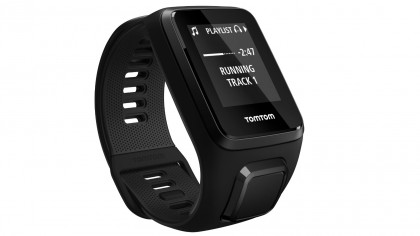TomTom's new lineup of devices tread new ground

TomTom is taking to IFA 2016 to announce its most capable lineup of wearables yet, along with a few car-based products that are focused on global markets outside of the US.
Starting with the wearables, whether you're a casual visitor to the local gym, or someone who can't get a good night of sleep without sore muscles, TomTom's latest batch of devices will have you covered.
The TomTom Touch (shown above) is, more or less, a basic fitness tracker. But inside of it lies a special trick that hasn't been done before in a piece of affordable fitness technology: body fat calculations.
Today's wearables are good at shouting a lot of numbers to you, but the Touch one-ups the rest by giving you information that is arguably more useful for becoming healthier. That is, knowing the split between your muscle mass and your body fat make-up.
Previously seen in the Fitbit Aria smart scale, the bio impedance analysis seen on display in the TomTom Touch checks the electrical impedance of your body's tissues layers. It then uses the results to estimate your body fat-to-muscle ratio. It sounds creepy, but it's painless, and pretty fun, to boot.
The Touch also packs in a heart rate monitor, activity and sleep tracking, phone notifications and robust third-party app integration from partners like MapMyFitness, Nike+ and more.
Best of all, the TomTom Touch is launching at $129 (£129.99, about AU$170,) which is - frankly - dirt cheap for what's on offer here. It will be available in early September in the US, with global availability coming later in the year.
Sign up for breaking news, reviews, opinion, top tech deals, and more.

It started with a Spark (3)
If the Touch is for casual users, the TomTom Spark 3 is aimed squarely at those who like to venture off the beaten path.
Like the Touch, it offers robust activity tracking, but it stands on its own with GPS tracking function built in.
In addition to simply telling you where you're going, the Spark 3's GPS capability also lets you share your treaded trails with friends, and lay GPS breadcrumbs on new ones. GPX files from other services, like Strava, can be imported onto the watch, too.
There are four different models of the Spark 3 to choose from. The standard option has everything listed above for $129. You can also nab a Spark 3 with 3GB of onboard storage built in, meaning you can sync up a set of Bluetooth headphones with the Spark 3 for wireless listening. Don't have a set of your own? No need to fret. TomTom is throwing in a set for free with the $149 version.
If monitoring your heart rate is important, then you'll want to opt for the $179 version of the Spark 3. If you want all of the goodies listed above (heart rate monitoring, 3GB onboard storage and headphones), it'll cost $250 when it launches in the US in October.

We're, like, adventurers
Last, but not least, TomTom is introducing the Adventurer, which packs in the features found in the most premium Spark 3 variation, plus some.
For $349, you'll get GPS tracking, heart rate monitoring, 3GB of onboard storage. In addition, the Adventurer is stocked with a barometer, which is crucial for measuring altitude.
It goes without saying that the TomTom Adventurer uses the barometer to good measure, extending support to extreme outdoor sports like snowboarding, skiing and hiking.
Oh, and you've got to love that slick orange band, too. This one is available in October.
Lost? Here are some new sat navs
Unfortunate for those who live in the US, TomTom's latest batch of satellite navigation systems won't make it outside of the UK and other global markets.
First off, the TomTom Go pairs with your iOS, Android, or Windows 10 Mobile device and acts as a voice-recognizing infotainment system. It can read out texts, detect changes in traffic and get lifetime updates over Wi-Fi for free. This new line of Go sat navs starts at about £220.
Next up is a device for those who get around on two wheels. The TomTom Vio clips onto a bike or scooter and enables turn-by-turn directions that you can hear with Bluetooth headphones. Also, there's a built-in speedometer to keep you in the know about how fast you're going. This one costs £149.99.
Lastly, a departure from the sat nav. The TomTom Curfer is for the car geeks. Just like a computer, today's modern vehicles spit out a bunch of numbers that are worth studying if you have a lot invested in them. It can provide details like battery voltage, current engine power load, brake efficiency and more. The Curfer retails for £59.99.
- Samsung's latest wearables: the Gear S3 Classic and Gear S3 Frontier

Cameron is a writer at The Verge, focused on reviews, deals coverage, and news. He wrote for magazines and websites such as The Verge, TechRadar, Practical Photoshop, Polygon, Eater and Al Bawaba.